The AMD Ryzen Threadripper 3960X and 3970X Review: 24 and 32 Cores on 7nm
by Dr. Ian Cutress, Andrei Frumusanu & Gavin Bonshor on November 25, 2019 9:05 AM ESTCPU Performance: Encoding Tests
With the rise of streaming, vlogs, and video content as a whole, encoding and transcoding tests are becoming ever more important. Not only are more home users and gamers needing to convert video files into something more manageable, for streaming or archival purposes, but the servers that manage the output also manage around data and log files with compression and decompression. Our encoding tasks are focused around these important scenarios, with input from the community for the best implementation of real-world testing.
All of our benchmark results can also be found in our benchmark engine, Bench.
Handbrake 1.1.0: Streaming and Archival Video Transcoding
A popular open source tool, Handbrake is the anything-to-anything video conversion software that a number of people use as a reference point. The danger is always on version numbers and optimization, for example the latest versions of the software can take advantage of AVX-512 and OpenCL to accelerate certain types of transcoding and algorithms. The version we use here is a pure CPU play, with common transcoding variations.
We have split Handbrake up into several tests, using a Logitech C920 1080p60 native webcam recording (essentially a streamer recording), and convert them into two types of streaming formats and one for archival. The output settings used are:
- 720p60 at 6000 kbps constant bit rate, fast setting, high profile
- 1080p60 at 3500 kbps constant bit rate, faster setting, main profile
- 1080p60 HEVC at 3500 kbps variable bit rate, fast setting, main profile
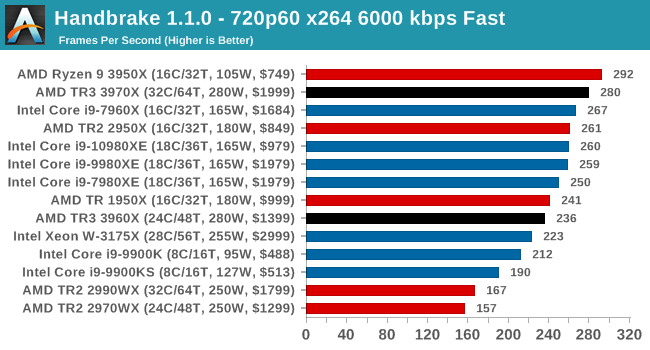
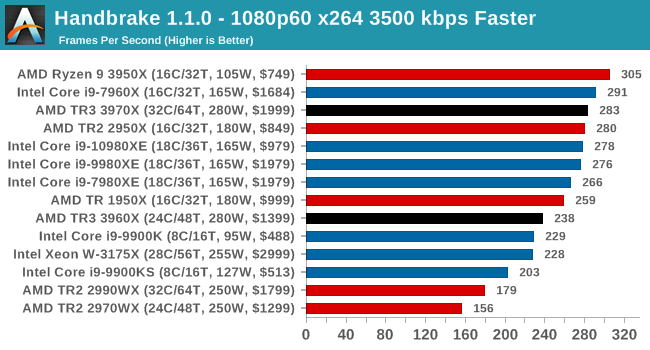

Video encoding is a little varied, based on the variable threaded nature. Certain encoding tests can be more memory sensitive here, or accelerated in different ways, or not scale well with more cores. Either way, TR3 performs a lot better than TR2, but the 3950X seems the best choice.
7-zip v1805: Popular Open-Source Encoding Engine
Out of our compression/decompression tool tests, 7-zip is the most requested and comes with a built-in benchmark. For our test suite, we’ve pulled the latest version of the software and we run the benchmark from the command line, reporting the compression, decompression, and a combined score.
It is noted in this benchmark that the latest multi-die processors have very bi-modal performance between compression and decompression, performing well in one and badly in the other. There are also discussions around how the Windows Scheduler is implementing every thread. As we get more results, it will be interesting to see how this plays out.
Please note, if you plan to share out the Compression graph, please include the Decompression one. Otherwise you’re only presenting half a picture.
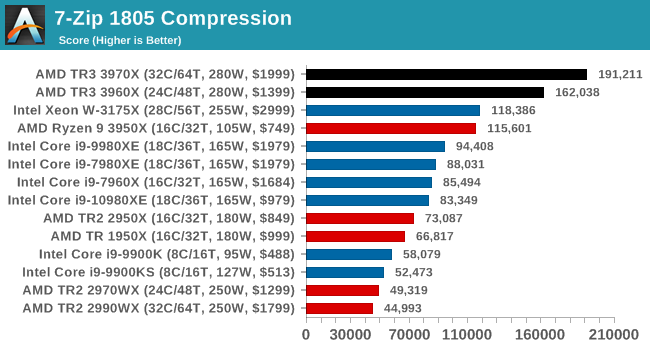
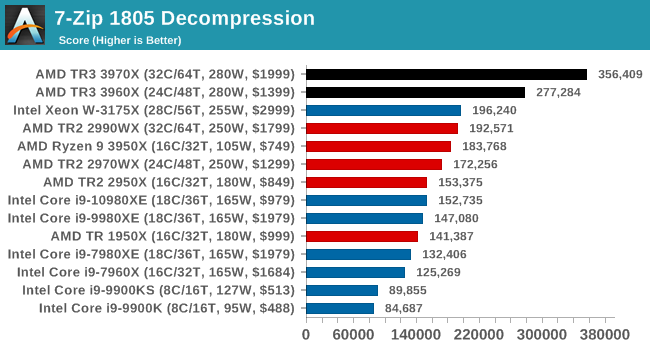
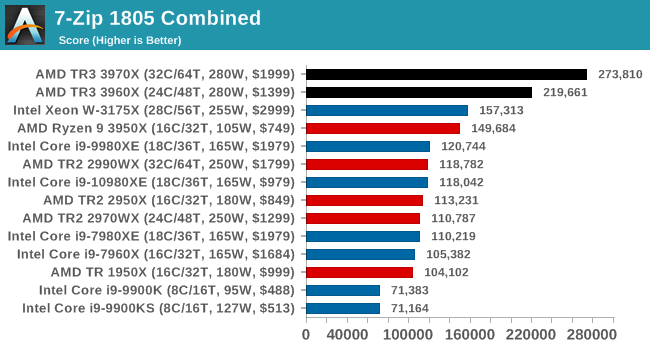
Easily parallel puts the TR3 well ahead of TR2 and Intel.
WinRAR 5.60b3: Archiving Tool
My compression tool of choice is often WinRAR, having been one of the first tools a number of my generation used over two decades ago. The interface has not changed much, although the integration with Windows right click commands is always a plus. It has no in-built test, so we run a compression over a set directory containing over thirty 60-second video files and 2000 small web-based files at a normal compression rate.
WinRAR is variable threaded but also susceptible to caching, so in our test we run it 10 times and take the average of the last five, leaving the test purely for raw CPU compute performance.
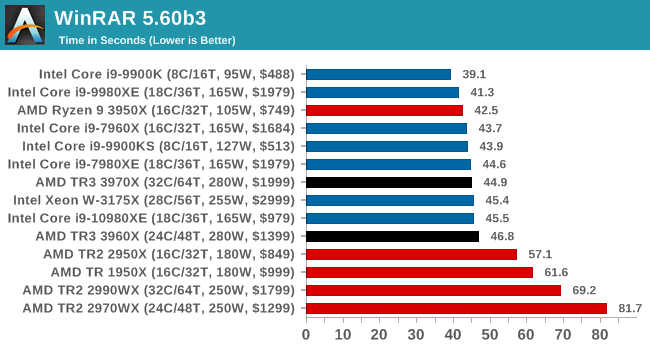
WinRAR is a variably threaded application, and both TR3 processors perform in the same ballpark as anything from Intel. Ideally we should have seen them streak ahead, but we seem to be at a point where CPU frequency or core counts are the limiting factor. At least with Zen 2, there are no issues as there was with Zen 1/Zen+.
AES Encryption: File Security
A number of platforms, particularly mobile devices, are now offering encryption by default with file systems in order to protect the contents. Windows based devices have these options as well, often applied by BitLocker or third-party software. In our AES encryption test, we used the discontinued TrueCrypt for its built-in benchmark, which tests several encryption algorithms directly in memory.
The data we take for this test is the combined AES encrypt/decrypt performance, measured in gigabytes per second. The software does use AES commands for processors that offer hardware selection, however not AVX-512.











245 Comments
View All Comments
mkaibear - Monday, November 25, 2019 - link
Intel had revenue of 19.2bn last quarter. The highest it's ever been for them.https://www.anandtech.com/show/15030/intel-announc...
Claiming that Intel is destroyed is laughable.
They're hurting at the moment, but then they were hurting in the Athlon era as well... and that didn't go so badly for them in the end.
For reference, AMDs revenue for the same period was 1.8bn. yes, Intel, despite all their problems, earned *ten times* what AMD did.
(Reference: https://www.anandtech.com/show/15045/amd-q3-fy-201...
Claiming Intel are destroyed is just fanboyism at its worst.
Xyler94 - Monday, November 25, 2019 - link
Unless Intel can get something out sooner rather than later, people are migrating to AMD because they are pushing things forward. 64 cores of Epyc fury is hitting them in the Server Space, which is where Intel is most scared of. They don't care that you or I buy an Intel chip or an AMD one, they care if Microsoft or Apple buys either or.Intel isn't destroyed, but they will be hurting for a while, as AMD is showing no signs of slowing down, and Intel has to beat what AMD makes next, not AMD today.
mkaibear - Monday, November 25, 2019 - link
Again, Intel have record earnings this last quarter. As in over the last 3 months. As in after two years of AMD kicking their backside in the server space they're still making record amounts of revenue.Intel aren't stupid, they're one of the most ruthless companies in the sector. They can throw five times as much as AMD's *total profit* in R&D and still make five times as much profit as AMD does.
Xyler94 - Monday, November 25, 2019 - link
Record breaking earnings mean nothing in the grand scheme of things.For as much as you gloat about Intel's RND, AMD is the one who's on top in 2 of the 4 markets (Laptops, Desktops, HEDT and Servers), some would argue 3. Doesn't matter how much money you can throw at a problem, it matters if you can solve it. AMD solved the problem, Intel hasn't, and it's a frantic state at Intel to make something happen, either get 10nm working better or changing their uArch in 14nm.
Right now, the only reason to consider a XEON over an Epyc would be for AVX-512 only workloads. Because otherwise, ServerTheHome has shown that Epyc dominates, especially the 7742 64 core part.
SwackandSwalls - Monday, November 25, 2019 - link
Those record breaking earnings (i.e. capital) mean a lot, and saying otherwise displays a large and intentional ignorance on how important capital is to the microprocessor industry. Intel can use that money to hire more both hardware and software talent, fund more research, build more fabs, outspend AMD in marketing, and on and on. If Intel had huge cash reserves but was putting up large losses every quarter then I'd be on board with your "grand scheme of things" comment. In reality they are massively profitable, selling more 14nm chips than they can produce, and have enough cash to not only learn from AMD's successes but also invest in following suit.Xyler94 - Monday, November 25, 2019 - link
Again, Hire all you want, throw as much money as you want. That doesn't matter if there's no results.AMD with literally tenths of Intel's funding can beat them, and have found better ways to make processors to increase core counts without sacrificing efficiency. Intel also needs to spend a lot of money on researching the node itself, AMD doesn't, so not all of Intel's RnD goes to making the CPU, lots of it goes into making the node itself.
So while Intel may make more, they have to spend way more, especially since CPUs aren't the only thing Intel makes (They make flash chips, 3D XPoint, Networking chipsets, and many other products, all vying for that sweet RND cash)
So while Intel makes more, they also spend more. Revenue is a great figure to look at on paper, but it doesn't amount to anything unless the spending is done wisely. AMD surely has shown that it doesn't take Intel levels of cash to become a market leader and capitalize on someone who's grown complacent.
milkywayer - Monday, November 25, 2019 - link
"record breaking numbers mean a lot".So what happened then, why is AMDs offering more power and cost efficient at a much much lower price?
Korguz - Monday, November 25, 2019 - link
mkaibear/SwackandSwalls, and point is ?? intel has all that money, yet.. been milking the SAME architecture for how many years ? as Xyler94 already said.. to keep throwing money at a problem, and it STILL doesnt get fixed, is NOT a good thing. AMD may not have the money that your beloved intel does, but guess what, they have been able to do MORE with what they do have, so tell me who is spending wiser ?? also.. how much of that 19.2 billion has intel had to dump into their fabs??imaheadcase - Monday, November 25, 2019 - link
I really hope you are not comparing Intell vs amd based on a just a CPU..that is illogical.TEAMSWITCHER - Monday, November 25, 2019 - link
Intel isn't "hurting" now... Desktop processors are not what most people want.